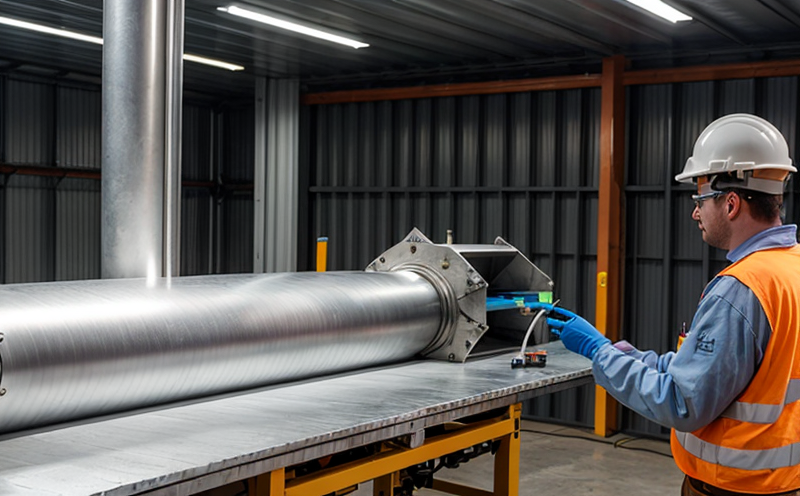UL 746C Weatherability Testing of Renewable Polymeric Materials
The UL 746C standard is a critical benchmark for assessing the durability and longevity of polymeric materials used in renewable energy applications. This test evaluates how well these materials withstand environmental factors such as ultraviolet light, moisture, temperature fluctuations, and ozone exposure over time. Understanding material performance under real-world conditions is essential to ensure the reliability and safety of renewable energy systems.
The testing process involves exposing samples to a controlled environment that simulates various aspects of outdoor weathering. This includes solar radiation, humidity, temperature variations, and air pollutants like ozone. The standard specifies precise exposure times and conditions based on the anticipated service life of the material in its intended application. For instance, materials used in photovoltaic panels or wind turbine blades are subjected to rigorous testing protocols designed to mimic their operational environment.
The UL 746C test is particularly important for renewable energy applications because it helps identify potential weaknesses in polymeric components that could lead to premature degradation or failure. By conducting this type of weatherability testing, manufacturers can improve product quality and extend the lifespan of their products, which ultimately contributes to more sustainable and cost-effective renewable energy solutions.
One key aspect of UL 746C is its focus on accelerated aging techniques that allow for faster evaluation of material performance. This approach enables developers and engineers to make informed decisions about material selection and design improvements without having to wait years for natural weathering effects to become apparent. Additionally, the test results provide valuable data that can be used in further research and development efforts aimed at enhancing material properties.
Another crucial element of UL 746C is its emphasis on reproducibility. The standard outlines detailed procedures and guidelines that ensure consistent testing results across different laboratories and facilities. This consistency is vital for maintaining high standards of quality control within the industry and facilitating international trade by ensuring compatibility with global regulatory requirements.
The UL 746C test plays a pivotal role in promoting innovation and technological advancement in renewable energy materials science. As new technologies continue to emerge, so too do challenges related to material durability and reliability. By adhering to rigorous testing protocols like those specified in UL 746C, researchers can confidently explore novel approaches while knowing that their work meets stringent industry standards.
In summary, the UL 746C weatherability test is an indispensable tool for evaluating polymeric materials used in renewable energy applications. Its ability to simulate real-world environmental conditions and provide consistent results makes it a cornerstone of quality assurance practices within this sector. Through thorough testing and continuous improvement based on these findings, we can strive towards creating more efficient, reliable, and sustainable renewable energy systems.
Benefits
The UL 746C weatherability test offers numerous benefits to manufacturers, developers, and consumers of renewable energy technologies. By ensuring that polymeric materials meet stringent durability requirements before being incorporated into products, this testing protocol helps reduce the risk of premature failure or degradation.
- Enhanced Product Reliability: Withstanding harsh environmental conditions is crucial for the longevity of renewable energy systems. The UL 746C test ensures that materials are capable of enduring these challenges effectively.
- Safety Assurance: Degradation or failure of key components could pose serious risks to personnel and equipment. By identifying potential issues early through rigorous testing, manufacturers can implement necessary changes to enhance safety measures.
- Cost Efficiency: Preventative maintenance and replacement costs are minimized when materials demonstrate robust performance over extended periods. This translates into lower overall operational expenses for both producers and end-users.
- Regulatory Compliance: Adhering to recognized standards like UL 746C demonstrates commitment to meeting regulatory requirements, thereby fostering trust among stakeholders and enhancing market credibility.
Ultimately, the UL 746C weatherability test serves as a vital link between innovation and practical application in renewable energy technology. It enables companies to develop safer, more efficient products that contribute positively to environmental sustainability goals.
Industry Applications
The results from the UL 746C weatherability test are widely applicable across various sectors within the renewable energy industry. Here’s a closer look at some key areas:
- Solar Photovoltaics (PV): Solar panels rely heavily on durable polymer encapsulants to protect sensitive electronics from environmental stresses. The UL 746C test ensures that these materials can withstand prolonged exposure to UV rays, moisture, and temperature changes.
- Wind Turbines: Blades made from advanced composites must be resistant not only to mechanical stress but also to harsh weather conditions such as rain, snow, and salt spray. This testing helps guarantee blade integrity throughout their operational lifecycle.
- Battery Packs: Lithium-ion batteries used in electric vehicles and grid storage systems require robust separators that can maintain optimal performance under extreme temperatures and humidity levels. The UL 746C test evaluates these separators’ ability to retain structural stability over time.
- Offshore Structures: Platforms supporting wind turbines or solar farms often face challenging marine environments characterized by corrosive salts, high winds, and frequent temperature swings. Testing materials used in these structures according to UL 746C ensures they can perform reliably even under such demanding conditions.
These examples illustrate how the UL 746C weatherability test impacts multiple facets of renewable energy infrastructure. By ensuring that critical components meet stringent durability standards, this testing process supports broader efforts towards environmental sustainability and economic growth within the sector.





